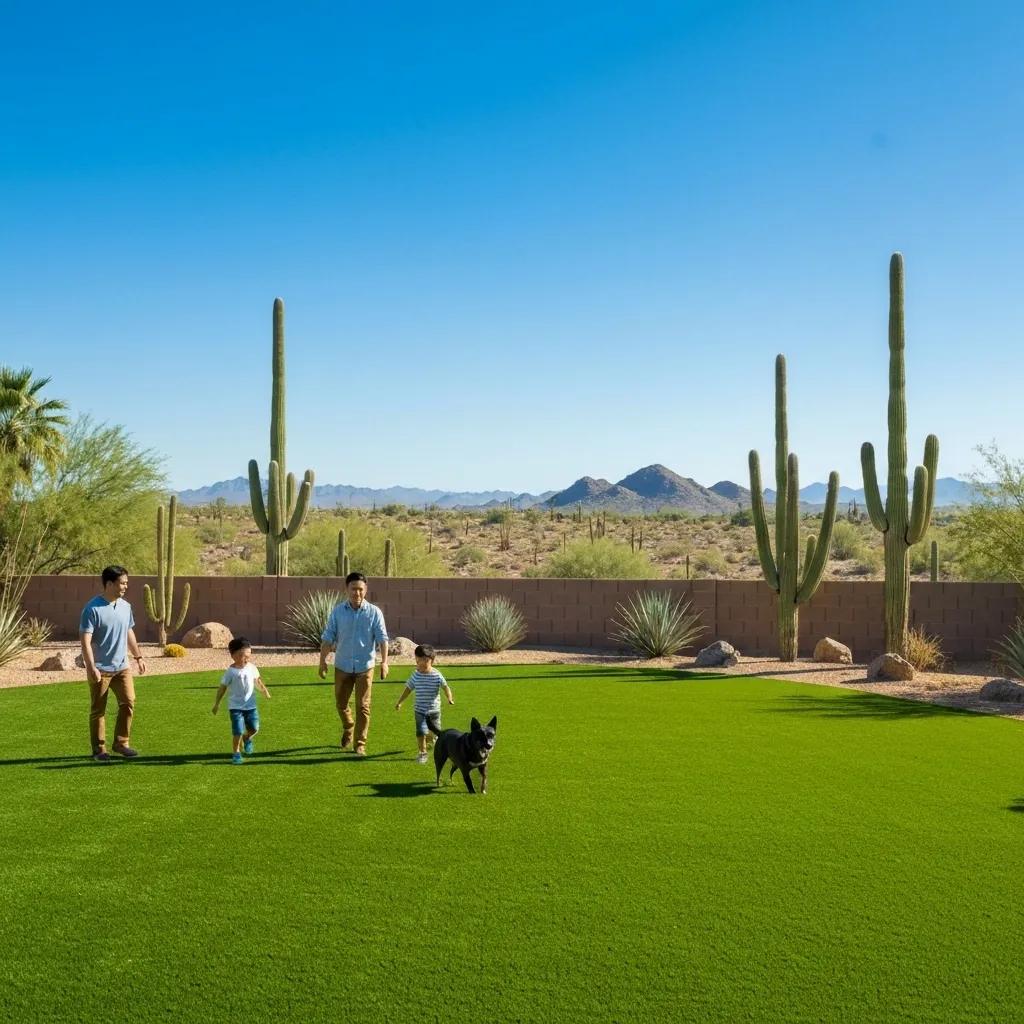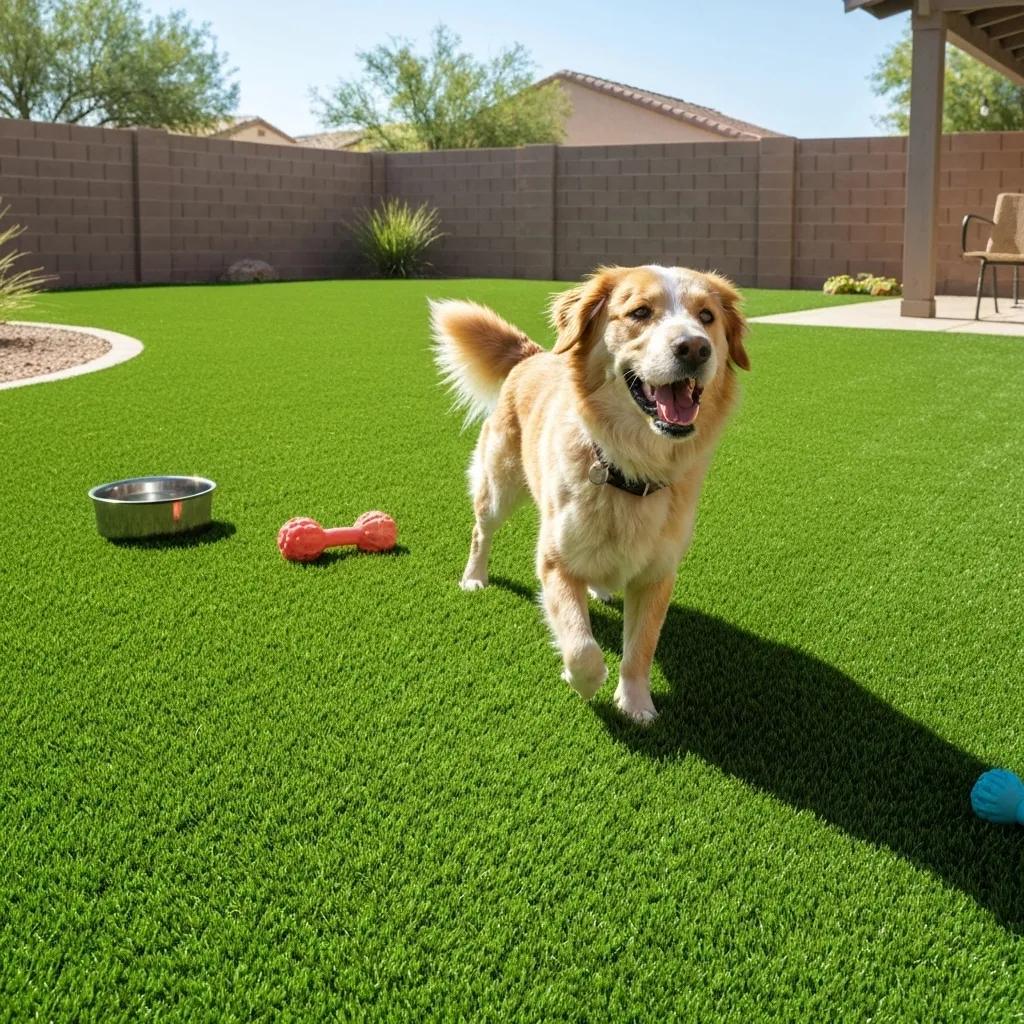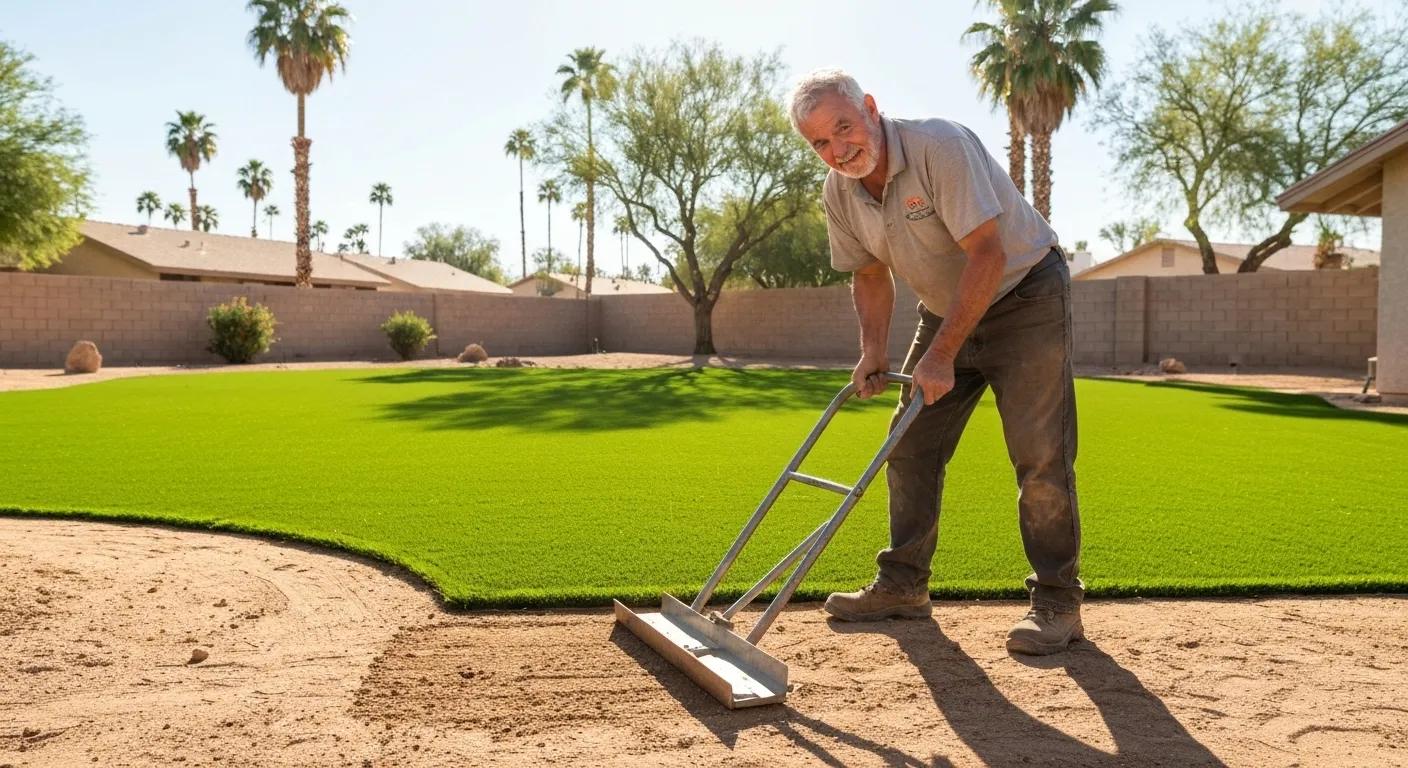
Transform your Phoenixlandscape with artificial turf, slashing outdoor water usage by up to 75% and boosting curb appeal while dramatically cutting down on maintenance. This comprehensive guide to Phoenix fake grass will show you how synthetic turf thrives in our arid climate, what influences its cost and return on investment, the top turf options—from furr-baby-friendly fibers to professional sports-grade blades—installation methods for both pros and DIYers, innovative cooling technologies, leading wholesale suppliers, and smart care tips. Whether you’re a seasoned landscaper, a busy contractor, a sports facility manager, an animal owner, or a business looking for bulk turf solutions, this guide is packed with actionable insights to help you make the best choice.
Artificial grass provides a consistently lush, green landscape in Phoenix‘s sandy soil by replacing water-thirsty natural grass with advanced engineered fibers and base layers. This not only conserves water but also significantly reduces labor and stands up to scorching temperatures. With its durable synthetic blades, superior drainage capabilities, and UV-stabilized backing, your landscape will remain vibrant under the desert sun, setting the stage for a closer look at costs, types, installation, cooling, and maintenance.
Artificial turf conserves water by eliminating the need for irrigation and facilitating rapid drainage through its permeable backing layers.
These water-saving benefits align perfectly with Phoenix‘s conservation goals and naturally lead to how artificial grass also minimizes upkeep demands.
Artificial grass requires minimal upkeep because its synthetic fibers stay perfectly trimmed, pest-free, and weed-resistant all year long. Engineered pile heights mean no more mowing, fertilizing, or pesticide applications, and integrated weed barriers stop unwanted growth in its tracks. Landscapers and facility managers appreciate a consistently beautiful surface that requires no seasonal chores, which naturally leads us to discuss how engineered turf holds up in the desertheat.
High-performance artificial turf is built to withstand triple-digit temperatures thanks to UV-stabilized yarns and heat-resistant infills that can lower surface temperatures by up to 50 °F. Specialized backing materials resist warping and degradation, and fiber pigments are designed to reflect sunlight rather than absorb it. This thermal resilience ensures exceptional durability for sports fields and commercial landscapes, highlighting its environmental advantages beyond just heat tolerance.
Synthetic grass contributes to a more sustainable environment by conserving water, eliminating chemical runoff from fertilizers, and reducing greenhouse gas emissions from lawnmowers. Its recyclable components and long lifespan—typically 15 to 20 years—also minimize waste and overall lifecycle impact. These ecological gains naturally lead to a discussion about costs and investment analysis in Phoenix.
In Phoenix, the cost of artificial grass typically ranges from $5 to $20 per square foot, fully installed, depending on the quality of the materials, pile height, and the complexity of the site. This straightforward pricing helps you understand the initial investment in relation to projected savings on water and labor, providing a solid financial foundation before we dive into the influencing factors, bulk purchase advantages, ROI, and available incentive programs.
Several key factors affect the price of synthetic turf:
Understanding these cost drivers is crucial for appreciating the wholesale pricing advantages available to bulk buyers.
Wholesale programs offer substantial savings for large orders through volume discounts and contractor rates on both turf and accessories. Bulk buyers gain access to lower per-unit material costs—often 10–30% less than retail prices—and more efficient logistics for pallet or truckload deliveries. This pricing model is particularly beneficial for landscapers and commercial developers who need consistent coverage across multiple sites, setting the stage for a closer look at return on investment.
Artificial grass provides a strong return on investment through:
These financial benefits effectively offset the initial installation costs, making engineered turf a smart long-term asset for both businesses and homeowners, and naturally leading us to discuss rebates and incentives.
Phoenix offers rebate programs that can provide up to \$1,500 for residential turf replacement and offer substantial funding for commercial properties transitioning to water-efficient landscaping. Additional incentives may be available through statewide conservation grants and HOA initiatives, effectively reducing the net cost of installation. Understanding these programs completes the financial picture and naturally leads to the critical decision of selecting the correct type of turf.
Artificial turf options in Arizona cater to various needs, including pet-friendly, commercial/sports, residential, and putting green applications, each featuring specific yarn types, backing systems, and infill configurations. Choosing the ideal product involves comparing performance specifications, as detailed in the following table.
| Turf Category | Pile Height | Drainage Rate |
|---|---|---|
| Pet-Friendly Turf | 1.25 in | 50 in/hr |
| Commercial Grade | 2.0 in | 40 in/hr |
| Residential Blend | 1.5 in | 35 in/hr |
| Putting Green Turf | 0.5 in | 30 in/hr |
This table highlights key differences, helping you select the best option for fur baby areas, high-traffic commercial spaces, family yards, or golf surfaces.

Pet-friendly turf is designed with odor-control infill, rapid drainage, and durable yarns to withstand energetic pets.
These features create a safe and hygienic surface for your pets, and they also inform how commercial or residential lawns can seamlessly incorporate dedicated pet zones.
Commercial and sports turf prioritize resilience, shock absorption, and consistent ball roll performance.
This performance-focused design naturally leads to considerations for residential applications and specialized accessories.
Residential blends offer a balance of softness and durability for everyday family yards, while putting green turf is engineered for true ball roll and precise grain control.
Understanding these distinctions is key before reviewing essential installation accessories.
Successful artificial grass installations depend on the right accessories, including infills, seam tape, edging stakes, and geotextile underlayment, all of which ensure stability and optimal performance.
| Accessory | Function | Benefit |
|---|---|---|
| Infill (Sand/Rubber) | Stabilizes turf fibers | Enhances blade resilience and adds weight |
| Seam Tape & Glue | Joins turf panels together | Creates seamless, secure connections |
| Edging Stakes | Anchors the turf perimeter | Prevents the turf from shifting or lifting |
| Geotextile Fabric | Acts as a weed barrier and separator | Improves drainage and base layer integrity |
Selecting the correct combination of accessories lays the groundwork for an efficient installation, which we will explore next.

Professional artificial turfinstallation in Phoenix involves precise site preparation and climate-specific techniques to ensure long-lasting results, leading to a step-by-step breakdown of the process.
This methodical approach informs how contractors can efficiently manage bulk installations for larger projects.
Contractors working on multi-site developments can streamline their operations by utilizing bulk pallets of turf, pre-fabricated edge restraints, and coordinated delivery schedules that align with project timelines. Expert advice from wholesale suppliers ensures product consistency across all jobs, helping to minimize delays and prevent cost overruns.
Phoenix‘s unique climate presents specific installation challenges, including shifting soils, intense UV exposure, and potential for monsoon-season runoff:
Anticipating these conditions during the installation preparation phase is crucial, and it also leads to considerations for DIY installations on smaller projects.
DIY installers can achieve great results by using pre-cut turf rolls, compacted base kits, and clear instructions on creating proper drainage slopes. Renting plate compactors and using accurate grading tools are essential for ensuring base stability. Purchasing in bulk from a wholesale partner guarantees consistent turf quality, leading to cost savings and professional-looking results for your self-managed projects.
Innovations in fiber pigments and infill materials allow artificial turf to remain comfortable even under the intense desert sun, paving the way for a closer look at these advanced cooling technologies.
Cooling technologies combine reflective pigment particles within the yarns with evaporative infills that release moisture to help dissipate heat. These systems can:
These engineered solutions offer significant improvements over standard turf, leading to measurable effectiveness.
Heat-resistant artificial turf products tested during Arizona‘s midsummer conditions registered surface temperatures 30–50 °F cooler than untreated alternatives. Independent field studies have confirmed enhanced comfort for barefoot users and reduced thermal stress for athletes, underscoring the value of investing in specialized turf systems.
Strategic installation techniques, including shading, proper orientation, and careful infill selection, can help mitigate surface heat:
These practices work in synergy with cooling infills to create a more comfortable environment for both people and pets.
Cooling infills not only lower peak surface temperatures but also provide essential shock absorption, making play areas safer for dogs and children. Evaporative cooling infills retain moisture from cleaning or occasional watering and release it gradually, creating a self-regulating thermal buffer that enhances comfort year-round.
Leading wholesale suppliers stand out through their commitment to product quality, transparent pricing, reliable logistics, and expert customer support, empowering bulk buyers to make informed decisions.
A dependable supplier provides certified product specifications, ensures on-time deliveries, and offers responsive customer support. Rigorous quality control processes verify critical metrics like face weight, UV stability, and drainage rates, guaranteeing that every roll meets performance promises and building trust with every shipment.
Wholesale programs offer tiered pricing structures, dedicated account managers, and personalized consultation services, from samples to on-site assessments. These resources accelerate project planning and help contractors maintain healthy profit margins across multiple installations, enhancing supply chain efficiency and customer satisfaction.
Wholesale buyers should focus on specifications that directly impact performance and longevity:
| Specification | Definition | Importance |
|---|---|---|
| Face Weight | Weight of the turf face in oz/yd² | Indicates the density and durability under traffic |
| Pile Height | Length of the yarn in inches | Affects the cushion, appearance, and feel |
| Drainage Rate | Capacity in gallons per square foot per hour | Determines how effectively the turf handles water |
| UV Stability | Resistance rating based on hours of exposure | Measures the turf’s ability to resist fading and degradation |
| Warranty | Coverage period and specific terms | Secures the long-term value of your investment |
Businesses can easily request tailored quotes and complimentary sample swatches by submitting their turf requirements, including square footage, intended application, and desired performance specifications. A straightforward online form or a direct conversation with a wholesale specialist can expedite the process, enabling swift decision-making for large-scale projects.
Proper maintenance of artificial turf ensures its peak aesthetic appeal and performance, extending its lifespan well beyond 15 years and completing the cycle of sustainable landscape solutions.
Routine maintenance involves biannual deep brushing and debris removal, along with quarterly inspections to check seam integrity and infill levels. This schedule helps maintain upright blades, prevent odor buildup, and identify any wear issues before they become significant, leading to best practices for pet-specific care.
For pet-friendly turf, weekly rinsing with water or a mild, pet-safe detergent is recommended to flush away odors. Periodically topping up the infill is also beneficial to maintain optimal drainage performance. Regular brushing with a stiff broom helps lift the blades, while using enzyme cleaners can effectively neutralize pet waste residues without harming animals, ensuring a consistently hygienic play surface.
Durable synthetic yarns and UV-stabilized backing significantly reduce the need for frequent replacements, leading to lower overall lifetime costs. A robust warranty, often spanning 10–15 years, provides assurance that wear-resistant fibers and backing materials will remain intact, minimizing maintenance beyond routine cleaning and reinforcing the value of professional installation standards.
Commercial landscapes and sports fields benefit greatly from annual professional servicing, which may include power grooming, infill replenishment, and seam reinforcement. Expert technicians can extend the turf’s lifespan and ensure safety, particularly in high-traffic areas, completing the maintenance cycle and keeping your Phoenixfake grass performing at its best.
Phoenix fake grass offers a drought-defying, low-maintenance solution that expertly handles desertheat while providing year-round green beauty. By understanding the water savings, cost factors, product varieties, installation best practices, cooling technologies, wholesale sourcing options, and upkeep requirements, landscapers, contractors, and property owners can confidently invest in synthetic turf. Partnering with a reputable wholesale supplier guarantees consistent quality, competitive pricing, and expert support for projects of any size. Embrace sustainable, vibrant landscapes in Arizona by choosing engineered artificial grass designed specifically for the demands of the desertclimate.
phoenix artificial grass, fake grass lawns, fake lawns, phoenix az artificial grass
phoenix artificial grass, fake grass lawns, fake lawns, phoenix az artificial grass